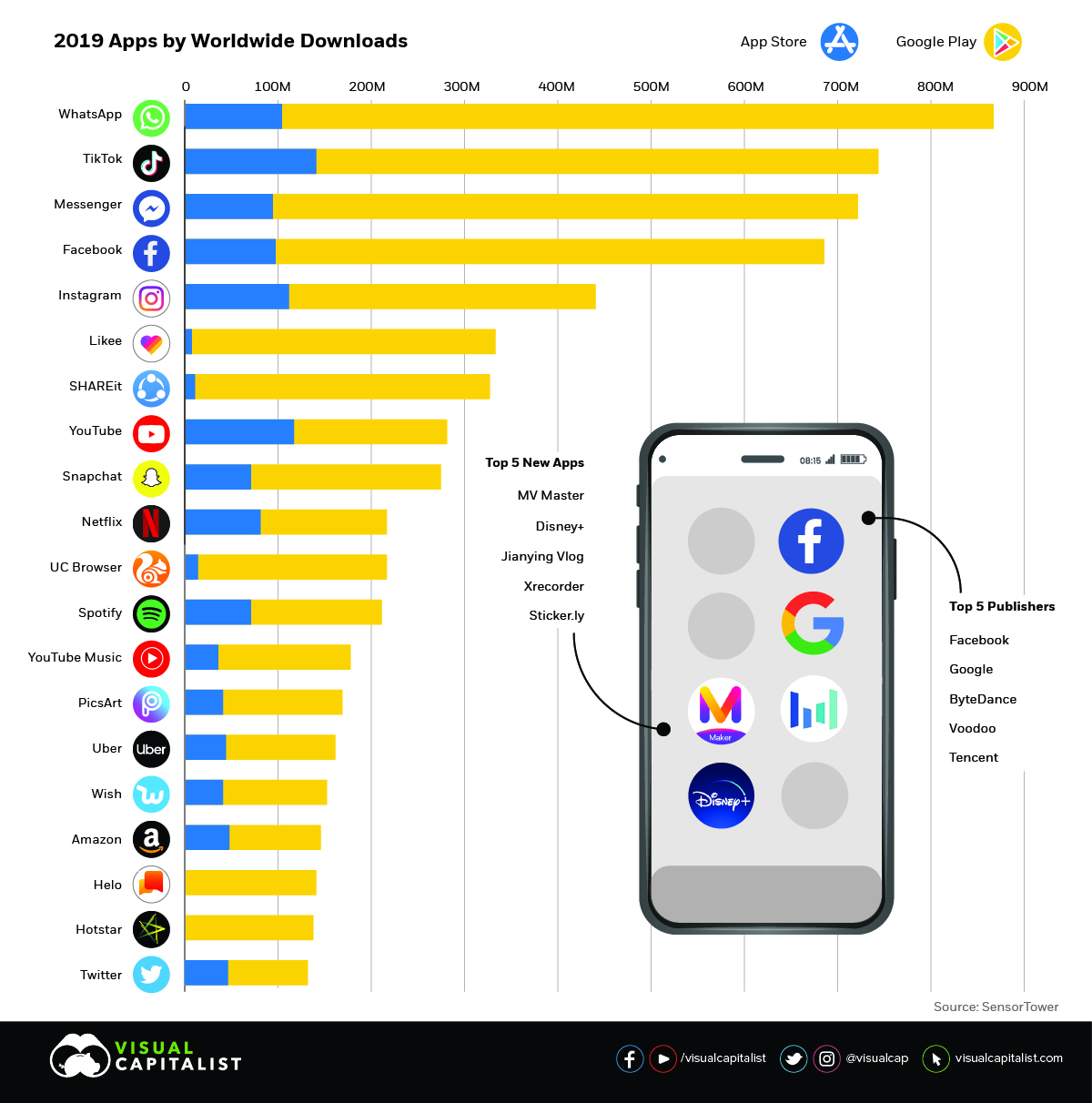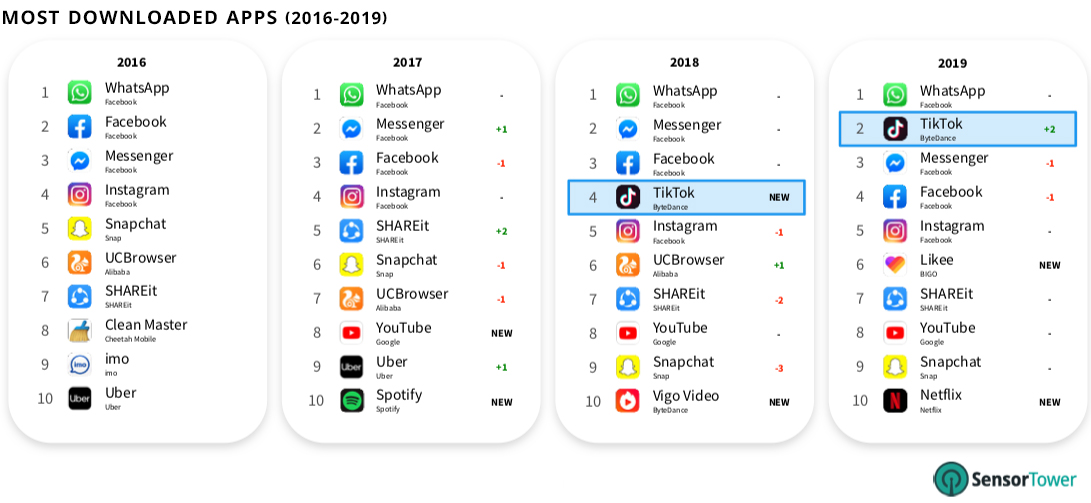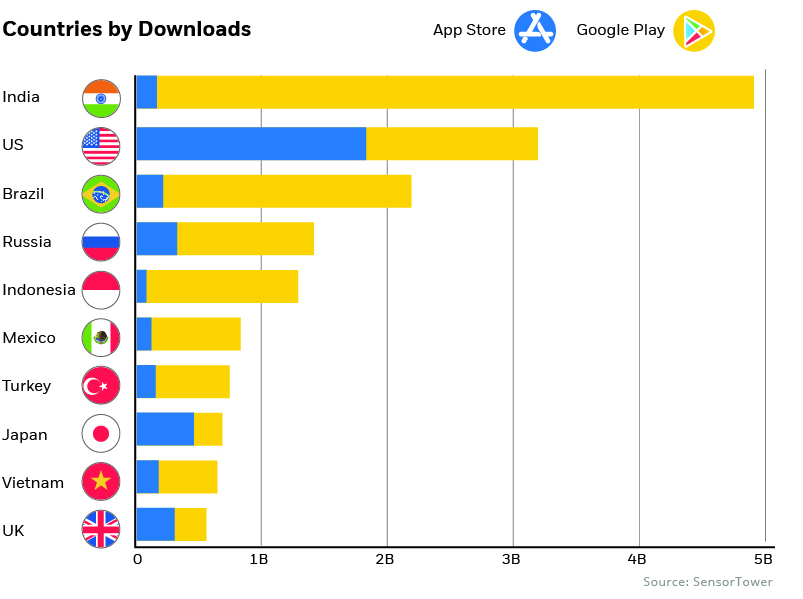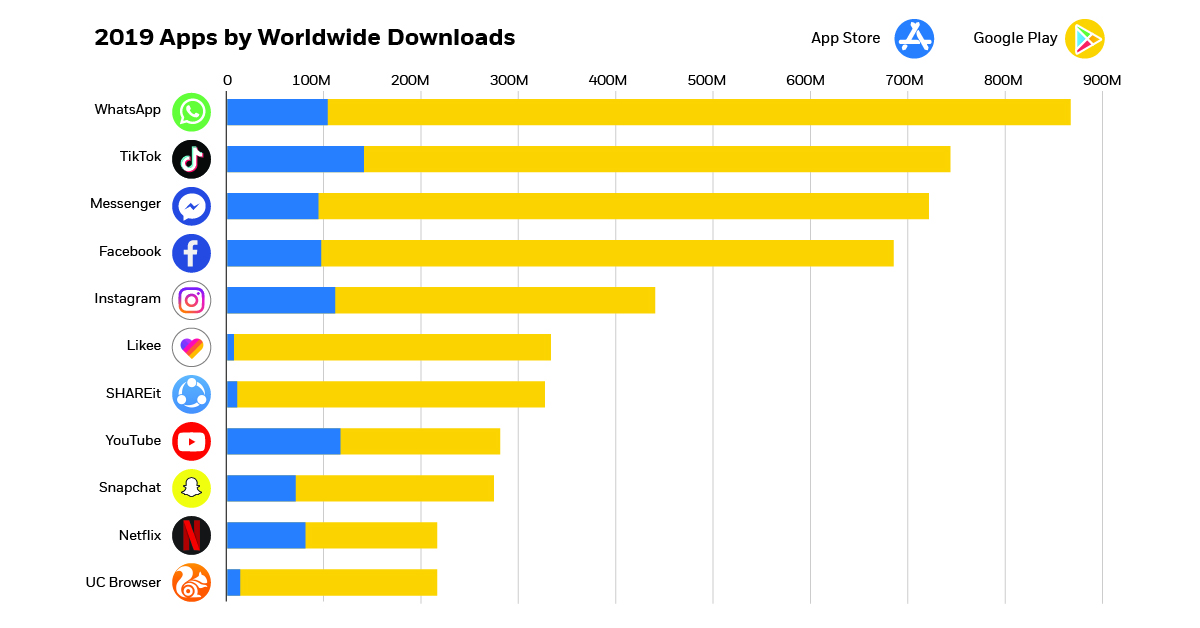Technology
Ranked: The World’s Most Downloaded Apps

Note: Estimates include unique installs on iPhone, iPad, and Google Play from Jan. 1 through Dec. 31, 2019. Pre-installed apps for Apple and Google are excluded.
Ranked: The World’s Most Downloaded Apps
From strategically finding love, to helping researchers search for extraterrestrial life—there is quite literally an app for almost anything these days.
It is therefore no surprise that apps have become one of the largest consumer ecosystems on the planet, with the global app economy expected to reach $6.3 trillion by 2021.
Today’s graphics pull data from a recent report by Sensor Tower that ranks the top 20 most downloaded apps of 2019. New entrants are rising up and threatening the dominance of more established tech companies—but can they sustain their current position on the leaderboard?
The Champions of the App Economy
According to the report, total app downloads grew to 115 billion in 2019, including almost 31 billion downloads on the App Store and 84 billion on Google Play.
Social media giant Facebook owns four out of five of 2019’s most downloaded apps: Facebook, Facebook Messenger, WhatsApp, and Instagram. Collectively, they boast an eye-watering 16 billion downloads—with WhatsApp holding the top spot for the fourth year running.
Growth in the short-form video category is apparent. The video creation app Likee joined this year’s ranking and sits in sixth place, with the majority of the app’s 330 million downloads coming from India.
The app lets users edit videos using a wide variety of effects, and directly competes with TikTok—a lip syncing app that entered the ranking in 2018 and now threatens WhatsApp’s position at the top of the leaderboard.
Which Apps Are Climbing the Ranks?
TikTok is the newest platform to turn its users into viral sensations, grossing $177 million in 2019. This is equal to more than five times its 2018 revenue. TikTok also bypassed Instagram in 2018, breaking Facebook’s foothold on the top four apps globally.

TikTok is owned by Chinese tech firm ByteDance, the most valuable private company in the world—and 78% of TikTok’s total Q4’2019 revenue came from its native country.
Aside from several short-form video entrants, new players from other industries continue to storm up the ranks. While they don’t make the list of most downloaded apps yet, their recent success could change that.
Streaming Services
Netflix is the only streaming service to make it into the top 20 most downloaded apps, but the launch of Disney+ could potentially change that.
Despite a November launch, Disney+ became the second most popular new app of 2019. Within a month, the service generated $50 million in revenue.
To put this into context, Disney+ acquired 34% of all streaming app downloads in less than three months, or 30 million subscribers—half of Netflix’s current 60 million U.S. subscribers. That figure also surpasses Hulu and Amazon Prime’s figures for the entirety of 2019.
Gaming
With 2.4 billion people playing mobile games in 2019, gaming is also set to become a major player in the app economy.
Two popular console franchises, Call of Duty and Mario Kart, recently entered the mobile market to become two of the most successful games in the category.
The free mobile version of Call of Duty had the second best quarter of any mobile game ever, with 170 million worldwide downloads. Only Pokémon GO had a better quarter, with more than 300 million installs when it launched in 2016.
The success of these apps can be attributed to their already established consumer base, and the evident shift in more gamers moving to mobile platforms as smartphone technology and processing speeds improve.
Countries Leading the App Economy
The app economy is also being fueled by growth in emerging markets including China, India, Brazil and Russia, thanks to faster internet speeds and increasing smartphone adoption rates.
Specifically, India’s increasing digitization is driving significant growth in the market. The country witnessed nearly 5 billion app installs in the last quarter of 2019—surging ahead of the U.S. with just over 3 billion installs.

Note: As Google Play is not available in China, the country was excluded from this chart.
India’s demand could be attributed to the fact that half of its 1.3 billion population is under the age of 25. A younger, tech savvy audience has resulted in India becoming TikTok’s top market, commanding 45% of the app’s first time downloads in 2019.
The App Economy 2.0
With an explosion in user spending, and seemingly endless opportunities for innovation, the global app economy shows a tremendous amount of promise, but is still in its early days.
Consumers spent $101 billion on apps globally in 2018. This is double the size of the global sneaker market, and nearly three times the size of the oral care industry.
—Danielle Levitas, EVP of Global Marketing & Market Insights at App Annie
Rising consumer spend combined with other forms of monetization, such as advertising and mobile commerce, could soon enable the app market to surpass the trillion dollar barrier in revenue.
While many experts claimed that the app industry was dead in its tracks, it’s safe to say that those predictions are now being irrefutably challenged.
Brands
How Tech Logos Have Evolved Over Time
From complete overhauls to more subtle tweaks, these tech logos have had quite a journey. Featuring: Google, Apple, and more.

How Tech Logos Have Evolved Over Time
This was originally posted on our Voronoi app. Download the app for free on iOS or Android and discover incredible data-driven charts from a variety of trusted sources.
One would be hard-pressed to find a company that has never changed its logo. Granted, some brands—like Rolex, IBM, and Coca-Cola—tend to just have more minimalistic updates. But other companies undergo an entire identity change, thus necessitating a full overhaul.
In this graphic, we visualized the evolution of prominent tech companies’ logos over time. All of these brands ranked highly in a Q1 2024 YouGov study of America’s most famous tech brands. The logo changes are sourced from 1000logos.net.
How Many Times Has Google Changed Its Logo?
Google and Facebook share a 98% fame rating according to YouGov. But while Facebook’s rise was captured in The Social Network (2010), Google’s history tends to be a little less lionized in popular culture.
For example, Google was initially called “Backrub” because it analyzed “back links” to understand how important a website was. Since its founding, Google has undergone eight logo changes, finally settling on its current one in 2015.
| Company | Number of Logo Changes |
|---|---|
| 8 | |
| HP | 8 |
| Amazon | 6 |
| Microsoft | 6 |
| Samsung | 6 |
| Apple | 5* |
Note: *Includes color changes. Source: 1000Logos.net
Another fun origin story is Microsoft, which started off as Traf-O-Data, a traffic counter reading company that generated reports for traffic engineers. By 1975, the company was renamed. But it wasn’t until 2012 that Microsoft put the iconic Windows logo—still the most popular desktop operating system—alongside its name.
And then there’s Samsung, which started as a grocery trading store in 1938. Its pivot to electronics started in the 1970s with black and white television sets. For 55 years, the company kept some form of stars from its first logo, until 1993, when the iconic encircled blue Samsung logo debuted.
Finally, Apple’s first logo in 1976 featured Isaac Newton reading under a tree—moments before an apple fell on his head. Two years later, the iconic bitten apple logo would be designed at Steve Jobs’ behest, and it would take another two decades for it to go monochrome.
-

 Green1 week ago
Green1 week agoRanked: The Countries With the Most Air Pollution in 2023
-

 AI2 weeks ago
AI2 weeks agoThe Stock Performance of U.S. Chipmakers So Far in 2024
-

 Markets2 weeks ago
Markets2 weeks agoCharted: Big Four Market Share by S&P 500 Audits
-

 Real Estate2 weeks ago
Real Estate2 weeks agoRanked: The Most Valuable Housing Markets in America
-

 Money2 weeks ago
Money2 weeks agoWhich States Have the Highest Minimum Wage in America?
-

 AI2 weeks ago
AI2 weeks agoRanked: Semiconductor Companies by Industry Revenue Share
-

 Travel2 weeks ago
Travel2 weeks agoRanked: The World’s Top Flight Routes, by Revenue
-

 Countries2 weeks ago
Countries2 weeks agoPopulation Projections: The World’s 6 Largest Countries in 2075















